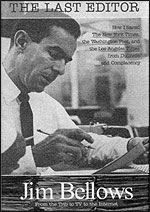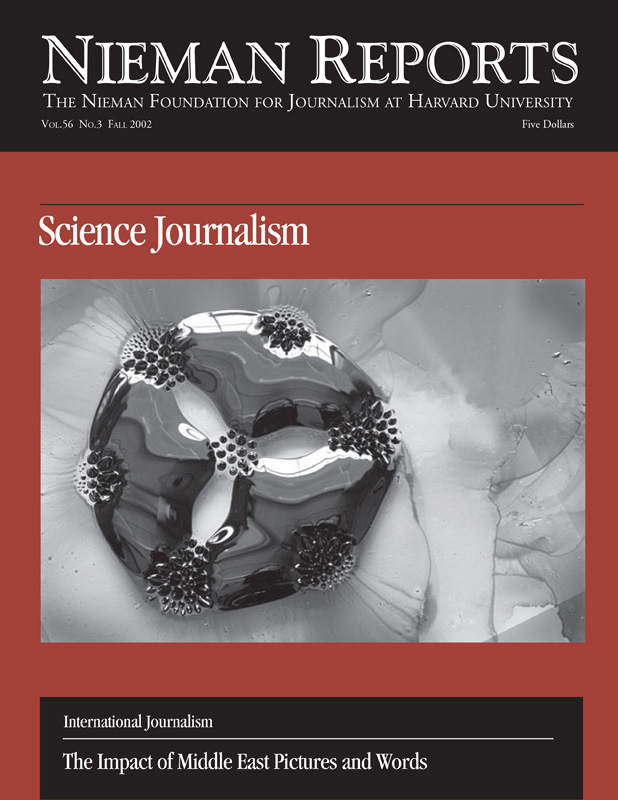
The Last Editor
How I Saved The New York Times, the Washington Post, and the Los Angeles Times from Dullness and Complacency
Jim Bellows
Andrews McMeel Publishing. 349 Pages. $28.95.
All the talk these days about the direction of American journalism seems to emanate from the Wall Street pronouncements of corporate CEO’s. Now, along comes Jim Bellows’ memoir, “The Last Editor: How I Saved The New York Times, the Washington Post, and the Los Angeles Times from Dullness and Complacency,” to remind us that even as newsroom executives are mired in ledger balances and spread sheets, it is still editors and reporters—and fine storytelling—that are the heart and soul of journalism.
From 1947 to 1981 Bellows worked for eight newspapers. Four of those newspapers—the Miami News, The New York Herald Tribune, The Washington Star and Los Angeles Herald-Examiner—no longer exist. But Bellows’ impact on these papers, particularly the Herald Trib, the Star, and the Herald-Examiner (second-place papers in their cities) has had a lasting significance on those communities, the competition, and the way news is reported. As noteworthy as anything he did to keep these struggling papers afloat and credible, Bellows ushered in “new journalism,” a then controversial movement that has evolved into the established practice of narrative journalism.
The book’s audacious title—like Bellows’ newspapering style—isn’t without some merit, seriousness and sheer fun. For a time, he did “save” these underdog newspapers and, in turn, revitalized the competition. In New York, Bellows needed to carve a place for the Herald Tribune to contrast it from the dull and plodding, but comprehensive, global and authoritative New York Times. Bellows also needed to position the paper apart from the city’s sensational tabloids.
In lively chapters, Bellows delights in tales of how his second-place papers pricked and punctured haughty community institutions—including the competition. In a Tribune article Tom Wolfe wrote about The New Yorker magazine, he described it as a painting of “a room full of very proper people who had gone to sleep standing up.” New Yorker Editor William Shawn responded by sending the Trib’s publisher a letter calling the article “libelous” and “a vicious, murderous attack.” When Trib publisher John Hay (Jock) Whitney asked Bellows what he was going to do, Bellows sent copies of Shawn’s letter to the press sections of Time and Newsweek. The story (and the Herald Trib) wasn’t just the talk of the town in New York, but this incident became the buzz of journalism around the nation.
About a decade later, in the nation’s capital, The Washington Star’s innovative gossip column, “The Ear,” pecked in a cheeky tone at the larger Washington Post as the “O.P.” (the Other Paper.) The column offered peeks into the personal doings of Post Editor Ben Bradlee and writer Sally Quinn (who would, in time, get married) as well as lofty D.C. political, cultural and social powers. It made the Star a daily topic of conversation around the capital.
The fun stuff shouldn’t overshadow Bellows’ devotion to serious news and the influence good reporting and writing can have on a community. Bellows brought Rowland Evans and Robert Novak together at the Herald Tribune for a national political column and later gave columnists Jack Germond and Jules Witcover the same opportunity at the Star. Each of these hires went on to become well recognized analysts for national political news.
The Trib examined New York City—the way the city was run and the impact the city’s bureaucracy and institutions had on people who lived there—under the microscope of strong metropolitan reporting. Jimmy Breslin’s articles about life in Harlem, based on reporting he did while living there, opened a window on the often-overlooked, largely African-American neighborhood. “City in Crisis,” a major series headed up by the late Dick Schaap, went beyond the daily tabloids’ overblown coverage of crime and petty corruption to look at the roots of the city’s problems and the systemic “smugness and indifference” that made these urban ills fester.
In 1979, when at the helm of the Los Angeles Herald-Examiner, Bellows took a news brief buried inside the Los Angeles Times about the police shooting of a 39-year-old black woman over the payment of a $22 utility bill and turned it into a major examination of the conduct of the city’s police department. Up to that time the Los Angeles Police Department (LAPD) was an institution that had been largely ignored by the Times and other local news operations. The Herald-Examiner’s reporting on the conduct of the LAPD was the first major examination of a police department that even now is struggling to recover from revelations of poor officer conduct and corruption.
The book, like Bellows’ personal style, has a staccato feel. Its pace is reflective of the directive Bellows gave Diana McLellan as she was starting as co-writer of the attention-grabbing gossip column “The Ear.” In the companion documentary, “The Last Editor,” broadcast on PBS stations around the nation, McLellan asked Bellows what he wanted the column to be. “Bip, bip, bip,” Bellows replied.
Each chapter is sprinkled with little “bips” from colleagues he nurtured along the way. There’s an introduction by Breslin, whom Bellows discovered and elevated to a columnist at the Herald Tribune. There are snippets of notes, memos and recollections from Tom Wolfe, whom Bellows brought to New York from Washington, D.C., where Wolfe was languishing at The Washington Post. There are notes and sidebars by Art Buchwald, Dick Schaap, Ben Bradlee, Pat Oliphant, Maureen Dowd, Ben Stein, Gail Sheehy, Judith Crist, Clare Booth Luce—well, you get the idea. At times, the book drips with the kind of name-dropping that Dick Schaap would have loved. You get the idea that Schaap came by his name-dropping honestly when early in his newspaper career he worked as city editor at the Herald Tribune under Bellows.
The writing isn’t grand. Bellows frankly admits he isn’t much of a writer and notes that the book is titled, “the last editor, not the last writer.” He had significant help crafting the book from Gerald Gardner. But that doesn’t diminish the fun we have in reading about his newspaper war stories or the lessons to be learned from them. “The Last Editor” is far more than a romp through the daisies of one person’s career. Bellows doesn’t come off as either stately or sagely, but as someone who was in critical places at critical times and believed that news is serious business in need of passion. Despite the constant budget cuts, clashes with publishers, strikes and daunting resources of the competition, Bellows is exuberant about his work and the sheer joy he finds in it.
Bellows offers some caution to those who care about the newspaper business today: “I’m afraid that newspapers have a perilous grasp on their souls today. They are fighting for eyeballs, advertising dollars, and the thumbs-up from Wall Street for maximizing profits (not serving the public) as their primary goal.” However, by the end of the book, Bellows is back to extolling the fun to be found in a newspaper career. “I encourage those of you burning with idealism to climb aboard. A career in news will let you change the world, and if you do it with passion and zeal, make it better. And you’ll have more fun than you ever dreamed work could provide.”
Seth Effron, a 1992 Nieman Fellow, is special projects director at the Nieman Foundation.



